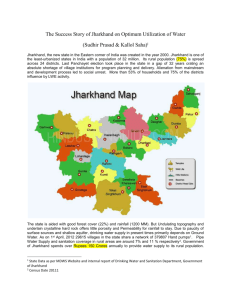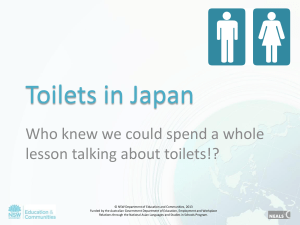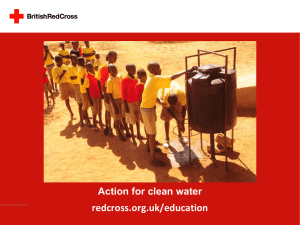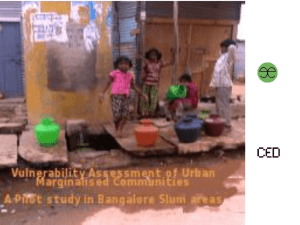Bhubaneshwar_27.01.2014_Final_Presentation_Compilation
advertisement
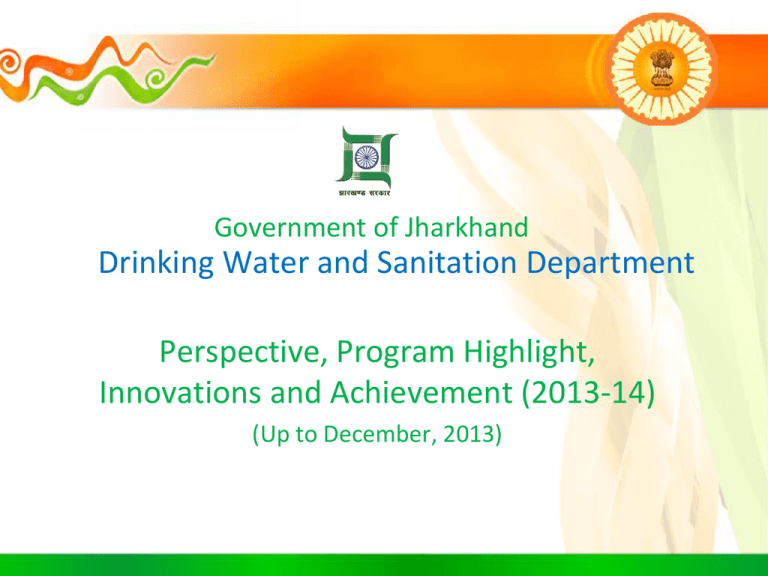
Government of Jharkhand Drinking Water and Sanitation Department Perspective, Program Highlight, Innovations and Achievement (2013-14) (Up to December, 2013) Jharkhand: A State that demands Special attention • The new state in the Eastern corner of India: Created in the year 2000. • Panchayet Election in 2011: After a gap of 32 years • More than 53% of households and 75% of the districts influence by LWE • Aided with good forest cover and rainfall • Undulating topography and hard rock terrain • Limited Availability of surface water • Rural Pipe Water Supply and Sanitation coverage : Around 7% and 43 % respectively • Sustainable Water and Sanitation solution : How do we achieve it?? Mission, Objective and Strategic Approach • Mission 2017: 12th Five Year Plan Period – 45% coverage through Rural Pipe Water Supply – 80% Coverage through Sustainable Sanitation facilities – Strategy: – Devolution of Power to Panchayet – Institutional Reform and Restructuring – Technical Backstopping – Stakeholder Engagement – Process Innovations encouraging last person participation Innovate , INNOVATE and INNOVATE Devolution of Power to Panchayet : Greater Accountability Institution Common to All Tiers Gram Panchayat Fund Function Functionary Administrative Sanction Recommendation of of Schemes Disciplinary Action less than Financial outlay Planning Single Village Scheme Casual Leave and of Rs.10 Lakh Administrative control of Site Selection and Program Plumber, Pump Implementation for DT, PWS, Operator, Hand Pump Sanitation, Water Shed and Mechanic Check Dam Collecting Fees for Water Utilization and WASH Pollution Panchayat Administrative Sanction Planning of Multi Panchayet Casual Leave and Samiti of Schemes with Schemes in the Same block and Administrative control of Financial outlay of Rs.10 Monitoring of scheme Junior Engineer and Lakh to 25 Lakh Implementation Assistant Engineer Zila Administrative Sanction Planning of Multi Block Schemes Casual Leave and Parishad of Schemes with in the Same District and Administrative control of Financial outlay above Monitoring of Scheme Executive Engineer Rs.25 Lakh to 50 Lakh Implemntation Institutional Reform and Restructuring: Trained and Qualified HR to enhance outreach • Placement of Institutional Structure Up to the Last Mile • Formation of Women led Village Water and Sanitation Committees: – 27957 VWSC are in Place – 25882 VWSC have Savings account • Civil Society Organizations as Block Resource Centre: Intensive Social Mobilization through16 organizations and 680 trained Human Resource – Covers 259 Blocks and 4562 Panchayets • District Project Management Unit: – Professional support to BRC and DWSM through 70 professionals • State Project Management Unit: – Engagement of 9 Subject matter Experts – Domains Covered: S&H, Legal & PRI, Hydro Geology, IEC, GIS, HRD, IT, Capacity Building, M&E and CLTS – Process of cabinet approval for central schemes is withdrawn – Amount is transferred to VWSC directly from District Mission Office. Technical Backstopping: Matching E-Governance and IT initiative to address WASH issues by expert HR • Development of Dedicated Website – daa.Jharkhand.gov.in • Establishment of call center: – Direct interaction with PRI representatives – SMS and Web Based Grievance Registration : Addressed 1000 grievance with 80% of issues solved on time • Fund transfer through Core banking Solution activated • Real Time Monitoring System (RTMS): – 212 GPS (Motorola MC 65) aided with micro-computing facilities – Dedicated scheme devised for Baseline Generation – Facility of participatory monitoring and verification • Dedicated Geographic Information System State Cell: – Regular use of HGM Map in Water Source identification – Cartographic and Spatial Database Unit in place – Decentralized Architecture for MIS & GIS being developed Stakeholder Engagement: Enhancing Capacity, Scope and Program Out Reach • Annual audit of VWSC accounts by independent Auditors – 10562 trained accountants working with VWSC and Gram Panchyats • Concurrent Evaluation by qualified agencies of highest repute – IIM Ranchi – National Institute of Financial Management • Thematic and Geographic involvement of Agencies of National and International credibility for capacity Building and Program implementation • • • • • • • WSP-SA in 4 Districts CLTS Task Force in 4 Districts GSF- NRMC in 4 Districts Water Aid in 4 Districts UNICEF in 2 Districts PRADAN and BASIX in Participatory Water supply schemes KRG Rain Water Foundation, Space Geo tech in Drinking Water Sustainability NATIONAL RURAL DRINKING WATER PROGRAM • Flow of Presentation – Program Update and over View – Process Innovation & New Development – PPP Model for Rural PWS – Incentivizing Participation through sensitive and flexible Pricing – Fund Transfer to VWSC – Results obtained : Financial Year wise comparative study Overview OF Progress: NRDWP (2013-14) SL No Particulars Number (s) 1 Revenue Village 29409 2 VWSC Formed 28407 3 Bank Account Opened 25994 4 Hand Pumps 379807 5 Pipe Water Supply Schemes 348 6 Pipe Water Supply Schemes (On going) 53 7 Schemes in Quality Affected Areas 237 8 PWS Handed Over 2804 9 Tool Kit Distribution 4862 10 Training & Skill Development 8846 11 Sanctioned RPWS Scheme 52 Process Innovations in NRDWP : Highlights & New Developments • Highlights – 120.18% habitation covered against 20 point Target during the FY 2012-13 – First Time Jharkhand Received additional Fund of Rs. 75.00 Crore from GoI in the Financial Year 2012-13 • New Developments – – – – – – – – Placement of District Project Management Unit (DPMU) Involvement of Village Water and Sanitation Committee (VWSC) Equipping Field officials with GPS and Geomorphological Maps Solar Based Pipe Water Supply Scheme Use of Pre Fabricated Water Tanks PRI Training on O & M of PWS & DT Partnership with NABARD, and NSDM Skill Development under Yuva Kaushal Vikash scheme • Repair of DT • Pipeline • Motor & Electrical Fitting PPP Model For Rural PWSS : Jharkhand State Key Obligations of Contractor Provide 55 LPCD/as per Demand by Community Training of VWSC Member O & M of Water Works Maintain Log Book for Water Supply & Complaint Registrar Round the clock availability of Operator Service Provision as per contract Collection of user charge VWSC Key Obligations of VWSC: Supervision for running Raw Water Supply for 6 Hours a Day Regularizing Illegal Connection before Handing Over Prevent illegal Consumptions Contractor Payment of user charge Water Users DWSC Key Obligation of DWSC: Assistance to Operator Monitoring and Supervision Operation and Maintenance of Rural Pipe Water Supply in PPP Mode SL No District Mini PWS ( No) 1 Medininagar 99 2 Garhwa 20 3 Sahebganj 29 4 Pakur 15 Cost Recovery Norm 1st Year 10% 2nd Year 20% 3rd Year 30% 4th Year 100% Incentivizing Participation through sensitive and Flexible Pricing • • • • • • Pioneering Effort by DWSD to enhance VWSC participation in managing PWS schemes Step Wise reduction from 4.40 (10-11) to 2.20 (11-12) and 1.10 (12-13) VWSC managed PWS schemes charged with Rs 1.10 per unit (Normal rate is Rs. 4.40 per unit) If a scheme fails to supply water , No Power connection provided Power cost previously accounting for 60% of the O &M is reduced to 40% More fund now available for O&M Electricity Bill Amount (Rs) Temporal Trend in Reduction of Electricity Charge as observed in Gadri village 60000 40000 20000 0 2010-11 2011-12 2012-13 Fund Transfer to VWSC For NRDWP Sl No Purpose Amount Transferred Purpose 1 O & M of DT 12 Crore Hand Pump Repair & Maintenance by VWSC 2 O& M of PWS 1 Crore Matching Grant equivalent to Amount Generated by VWSC 3 Sustainability 28.36 Crore Water Harvesting Structure being constructed by VWSC* 4 DPR Preparation 10 Crore Developing Rural Pipe Water Supply Scheme by VWSC *Jal Sahiya is provided Rs.500 as incentive For monitoring and supervision of Soak pits. This is the highest amount provisioned for JS for any activity to be taken up by them. This is to popularize the concept of Rain Water Harvesting and conservative use of Water in Rural context. Enhanced O &M, Sustainability and Water Quality Monitoring and Surveillance • O & M of PWS By VWSC : – 2804 schemes transferred – 4197 Single village Schemes in pipe line – Tool kits for hand pump repairing distributed among 4562 gram Panchyats • Pilot projects on Dinking Water Sustainability – 10 Water qualities affected and Water stressed block • Water Quality – Quality of 29132 samples tested through Field Test Kits. – Field Test Kits among 26047 Jal Sahiyas in all 24 districts – Fully equipped laboratories have been established in 14 District • Total 2929 Samples tested in Laboratory VWSC Managed Pipe Water Supply scheme : Breaking the myth that Poors Don’t Pay S. N. 1 2 3 4 5 6 7 8 9 10 11 12 13 14 15 16 17 18 19 20 Name of the Village ShivalbariUttar Shivalbari Dakshin Shivalbari East Shivalbari Central Agayarkund South Agayarkund Uttar Medha Vrindavanpur Jaynagar Sarai Kella Charadih Bero Nuamundi (Bazar Samity) Mahudi Khijri MandarTigoe Barasi Meru Rasonia Kalubira, Simdega Connections User Fee collection in Rupees 450 196 455 230 395 196 322 120 500 142 213 207 192 270 200 180 138 120 188 140 179,640 123,743 387,789 134,451 256,772 143,000 142,413 35,000 100,000 123,350 238,540 70,000 10, 00,000 2,65,000 112,506 40,000 60,000 160,000 202,000 60,000 Financial Year Wise Physical Achievement up to December 12132 8182 6430 2876 3661 2010-11 16546 19110 14735 20000 18000 16000 14000 12000 10000 8000 6000 4000 2000 0 2011-12 Target 2012-13 Acheivement 2013-14 Financial Year Wise up to December OB+ Release& Expenditure under NRDWP 89.84 98.68 143.94 100 55.06 150 157.11 200 164.1 209.95 300 250 267.57 Central Share (Program Fund) in Crores of Ruppees 50 0 2010 -11 2011 -12 Total Available Fund 2012 -13 2013 -14 Expenditure Up to December Percentage of Physical and Financial Progress Percentage Progress (Physical)67.44 80 60 40 24.85 33.65 17.38 20 0 2010-11 2011-12 2013-14 Percentage Progress (Financial) 80 62.41 60 40 2012-13 61.33 47 35.05 20 0 2010-11 2011-12 2012-13 2013-14 Nirmal Bharat Abhiyan: • Flow of Presentation – Program Update and over View – MGNREGS Convergence and conjoint Approach – Reinventing Revolving Fund to address Slip Back – Piloting Bio Toilet initiative in Jharkhand – Involving Corporate Social Responsibility – Results obtained : Financial Year wise comparative study – Upcoming Activities Nirmal Bharat Abhiyan: Program Update and over view • Nirmal Bharat Abhiyan – – – – 45000 individual household toilets ;199 Institutional Toilets 400 Open Defecation Free Villages in a span of 18 months Pilot Project on Bio Toilet and SLWM taken up State made it mandatory for aspiring PRI electoral candidates to have sanitary toilets in their houses as a pre-qualification • The candidates will have to obtain a certificate from Gram Sabhas certifying that they have a toilet in their house for contesting elections. – CSR involvement in Sanitation initiated – Government is considering making toilet pans VAT free • To bring down the input cost of Individual Household latrine construction cost Convergence and Conjoint Approach: MGNREGS & NRLM • Funds released to various Gram Panchyats for toilet construction under MNREGA convergence – – – – – – • • • Deoghar Koderma Godda Latehar Lohardagga Ranchi A proposal to construct 1.5 lakh toilets under MNREGA has been approved By 2014 DWSD envisage to construct 2 lakh to 2.5 lakh toilets in the state Partnership worked out between the NBA, NRDWP and JSLPS (Jharkhand State Livelihood promotion Society – – – The engagement of the Self Help Group (SHG) women Strengthen Village Water and Sanitation Committee (VWSC) Enhancing social capital to the Nirmal Bharat Abhiyan Sanitation Saturation approach Reinventing Revolving Fund • • Implementation strategy revolving around the “saturation approach” Fundamental Belief – Shift from targeting families to targeting communities – No longer counting toilets but taking stock of ODF villages – Complements BCC & CLTS with Financial Provisioning • Implementation Steps • • – Total population of the village as unit – Target for “open defecation Free Village – VWSC to have community consensus on achieving ODF status – the slip back households to opt for new toilets – Access a loan from the District Water and Sanitation Mission (DWSM). Loan is supplied using provisions of the Revolving Funds(Rs. 50 lakhs per district) Loan Repaid from incentive/ Labour Payment afterwards Piloting Bio Toilet , Pay and Use Community toilet and Solid Liquid Waste Management Initiative in Jharkhand • • • • • Pay and Use Toiltes initiated in 4 locations ;SLWM is being piloted in 2 Locations CSR being involved in 4 dedicated Projects – Hindustn Copper Limited at East Singhbhum – Ultratech Cement at Koderma – TATA Power at East Singhbhum – Eastern Coalfields Limited at Godda Dedicated handbook regarding different program component being prepared In all flagship scheme there is provision for Block Resource Centre; However mostly remains non functional. DWSD out sourced it to few CSOs. CSOs are working as Project Management Consultants; This enhanced, smoothen and regularize Work flow without any Strike or interruption Research and Development & Upcoming activities • First phase of R &D project on Sustainability research is nearing completion started in collaboration with Columbia University. The project works on – Rain water Harvesting & Ground Water Recharge – Using mines pit water for drinking purpose • Aerobic Bio-Toilet piloted in collaboration with Stone Biotech – Deoghar Shravani mela – Scaling up proposed in Community Toilets • 4 Anaerobic Bio toilet is proposed to be piloted in 4 community toilets on pilot basis with facilitation from UNICEF – Ranchi, Hazaribag, West Singhbhum and Gumla • • Training on Accounts maintenance by Jal Sahiya Orientation Training of MLA & MPs on WASH issues
